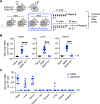Tolerance to non-inherited maternal antigen is sustained by LysM+ CD11c+ maternal microchimeric cells
- PMID: 40902588
- PMCID: PMC12412910
- DOI: 10.1016/j.immuni.2025.08.005
Tolerance to non-inherited maternal antigen is sustained by LysM+ CD11c+ maternal microchimeric cells
Abstract
Maternal-fetal microchimerism is increasingly linked with both inflammatory disorders and immune tolerance phenotypes. However, finding microchimeric cells in target tissues does not establish causality, which require platforms for manipulating these rare and heterogeneous cells. Here, we studied maternal microchimeric cells (MMc) that sustain non-inherited maternal antigen (NIMA) tolerance. Complete MMc depletion overturned hallmark features of NIMA-specific tolerance including FOXP3+ regulatory T cell expansion and cross-generational resiliency against fetal wastage. Stepwise depletion of individual MMc subsets showed that NIMA-specific tolerance is sustained exclusively by microchimerism in maternal LysM+ CD11c+ Vav1+ leukocyte cells. Interestingly, conditional depletion of these tolerogenic cells does not diminish overall MMc levels, dissociating NIMA-specific tolerance from MMc persistence. Thus, tolerance to maternal alloantigens is maintained by only a small fraction of MMc identified by LysM and CD11c co-expression, with persistence of remaining MMc highlighting remarkable adaptation to allogeneic maternal cells acquired in this early-life developmental context.
Keywords: immune tolerance; microchimerism; non-inherited maternal antigen; regulatory T cell; transplantation.
Copyright © 2025 The Authors. Published by Elsevier Inc. All rights reserved.
Conflict of interest statement
Declaration of interests The authors declare no competing interests.
Figures







References
MeSH terms
Substances
Grants and funding
LinkOut - more resources
Full Text Sources
Molecular Biology Databases
Research Materials
Miscellaneous

